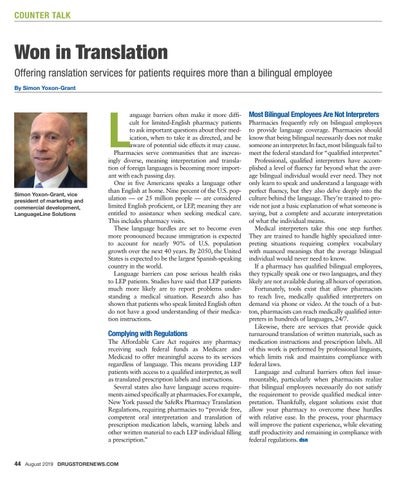COUNTER TALK
Won in Translation Offering ranslation services for patients requires more than a bilingual employee By Simon Yoxon-Grant
L Simon Yoxon-Grant, vice president of marketing and commercial development, LanguageLine Solutions
anguage barriers often make it more difficult for limited-English pharmacy patients to ask important questions about their medication, when to take it as directed, and be aware of potential side effects it may cause. Pharmacies serve communities that are increasingly diverse, meaning interpretation and translation of foreign languages is becoming more important with each passing day. One in five Americans speaks a language other than English at home. Nine percent of the U.S. population — or 25 million people — are considered limited English proficient, or LEP, meaning they are entitled to assistance when seeking medical care. This includes pharmacy visits. These language hurdles are set to become even more pronounced because immigration is expected to account for nearly 90% of U.S. population growth over the next 40 years. By 2050, the United States is expected to be the largest Spanish-speaking country in the world. Language barriers can pose serious health risks to LEP patients. Studies have said that LEP patients much more likely are to report problems understanding a medical situation. Research also has shown that patients who speak limited English often do not have a good understanding of their medication instructions.
Complying with Regulations
The Affordable Care Act requires any pharmacy receiving such federal funds as Medicare and Medicaid to offer meaningful access to its services regardless of language. This means providing LEP patients with access to a qualified interpreter, as well as translated prescription labels and instructions. Several states also have language access requirements aimed specifically at pharmacies. For example, New York passed the SafeRx Pharmacy Translation Regulations, requiring pharmacies to “provide free, competent oral interpretation and translation of prescription medication labels, warning labels and other written material to each LEP individual filling a prescription.”
44
Most Bilingual Employees Are Not Interpreters
Pharmacies frequently rely on bilingual employees to provide language coverage. Pharmacies should know that being bilingual necessarily does not make someone an interpreter. In fact, most bilinguals fail to meet the federal standard for “qualified interpreter.” Professional, qualified interpreters have accomplished a level of fluency far beyond what the average bilingual individual would ever need. They not only learn to speak and understand a language with perfect fluency, but they also delve deeply into the culture behind the language. They’re trained to provide not just a basic explanation of what someone is saying, but a complete and accurate interpretation of what the individual means. Medical interpreters take this one step further. They are trained to handle highly specialized interpreting situations requiring complex vocabulary with nuanced meanings that the average bilingual individual would never need to know. If a pharmacy has qualified bilingual employees, they typically speak one or two languages, and they likely are not available during all hours of operation. Fortunately, tools exist that allow pharmacists to reach live, medically qualified interpreters on demand via phone or video. At the touch of a button, pharmacists can reach medically qualified interpreters in hundreds of languages, 24/7. Likewise, there are services that provide quick turnaround translation of written materials, such as medication instructions and prescription labels. All of this work is performed by professional linguists, which limits risk and maintains compliance with federal laws. Language and cultural barriers often feel insurmountable, particularly when pharmacists realize that bilingual employees necessarily do not satisfy the requirement to provide qualified medical interpretation. Thankfully, elegant solutions exist that allow your pharmacy to overcome these hurdles with relative ease. In the process, your pharmacy will improve the patient experience, while elevating staff productivity and remaining in compliance with federal regulations. dsn
August 2019 DRUGSTORENEWS.COM
044_DSN_ LanuageLine_v2.indd 44
8/6/19 9:52 AM
